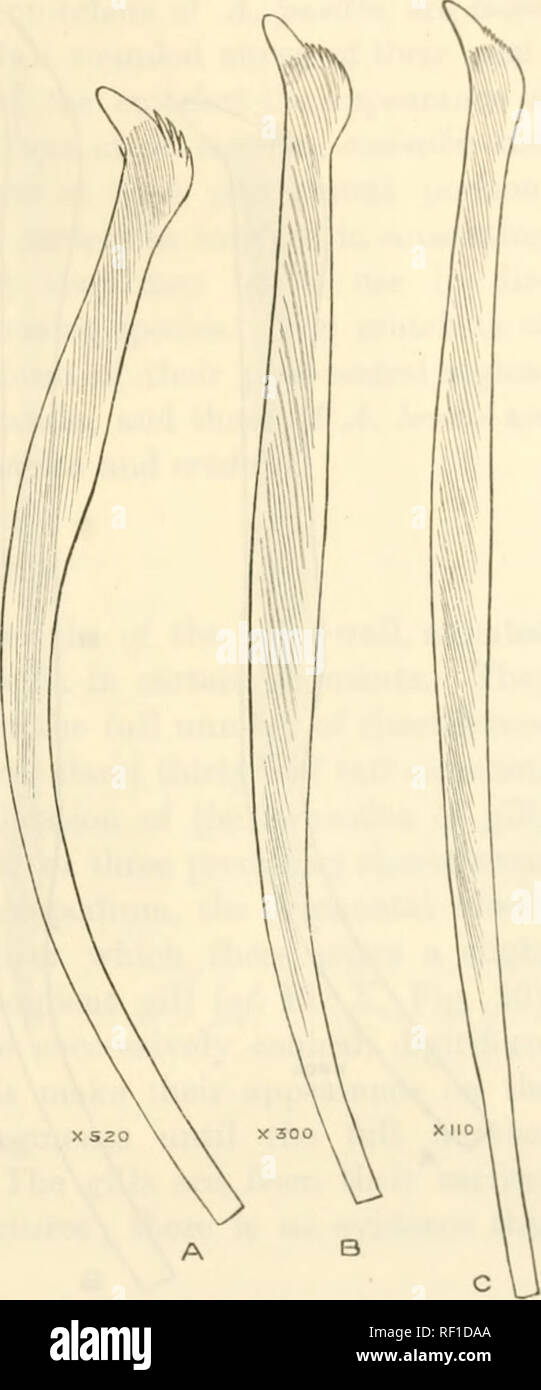. Catalogue of the Chaetopoda in the British Museum (Natural History). Oligochaeta; Polychaeta. Crotchets of Arenicola 53 of A. marina and imsilla in the form of tlieir post-rostral region. A. loveni.—Crotchets of large examples only, exhibiting late growth-characters, are available (Fig. 27, A from the type specimen and B from a similar specimen collected in Saldanha Bay). They are intermediate in their characters between those of A. marina and cristata, but are, on the whole, rather nearer those of the latter species. A. ecaudata and hranchialis.— The crotchets of these two species are pract

Image details
Contributor:
The Book Worm / Alamy Stock PhotoImage ID:
RF1DAAFile size:
7.1 MB (161 KB Compressed download)Releases:
Model - no | Property - noDo I need a release?Dimensions:
1020 x 2450 px | 17.3 x 41.5 cm | 6.8 x 16.3 inches | 150dpiMore information:
This image is a public domain image, which means either that copyright has expired in the image or the copyright holder has waived their copyright. Alamy charges you a fee for access to the high resolution copy of the image.
This image could have imperfections as it’s either historical or reportage.
. Catalogue of the Chaetopoda in the British Museum (Natural History). Oligochaeta; Polychaeta. Crotchets of Arenicola 53 of A. marina and imsilla in the form of tlieir post-rostral region. A. loveni.—Crotchets of large examples only, exhibiting late growth-characters, are available (Fig. 27, A from the type specimen and B from a similar specimen collected in Saldanha Bay). They are intermediate in their characters between those of A. marina and cristata, but are, on the whole, rather nearer those of the latter species. A. ecaudata and hranchialis.— The crotchets of these two species are practically identical in size and form. They do not attain so great a size as the crotchets of the caudate species; for they appear not to exceed "4 mm. in length, whereas in large examples of A. loveni the crotchets attain a length of '8 mm., in A. marina and cristata '9 mm., and in A. assimilis and pusilla 1 • 1 mm. A crotchet from a post-larval A. ecaudata, 8 mm. long, is shown in Fig. 28, and presents the usual characters found in small crotchets. Fig. 29 represents two crotchets from the same neuropodium of an adult A. ecaudata 200 mm. long. There were in this neuropodium 120 crotchets, of which Fip 24.-^. ;j««Wa a, crotchet from a Nea- yjgr 25 A crUtata pohtan specimen, 1( mm. long; B, Irom the First crotchet of a the Small OUC WaS type specimen ; C, From a large specimen, larva 25 mm. long. i i i ^*'^ '"'"• '°"^'' ^™"^ ^ nalaska. the most dorsal and was about to be cast out, while the large one was just coming into use at the ventral end of the series. There is not usually so much difference in size between the extreme crotchets in the neuropodia of A. hranchialis. The rostrum of the crotchets of both these species. Please note that these images are extracted from scanned page images that may have been digitally enhanced for readability - coloration and appearance of these illustrations may not perfectly resemble the original work.. Ashwo